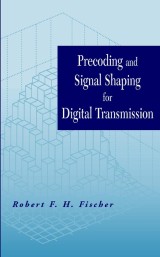Details

Precoding and Signal Shaping for Digital Transmission
IEEE Press 1. Aufl.
|
144,99 € |
|
| Verlag: | Wiley |
| Format: | |
| Veröffentl.: | 28.01.2005 |
| ISBN/EAN: | 9780471727729 |
| Sprache: | englisch |
| Anzahl Seiten: | 504 |
DRM-geschütztes eBook, Sie benötigen z.B. Adobe Digital Editions und eine Adobe ID zum Lesen.
Beschreibungen
Provides a step-by-step description of the basics of precoding and signal shaping.<br /> * Illustrates theory with examples from wireline and wireless communications.<br /> * Discusses the role of precoding and signal shaping algorithms in communications standards.
Preface.<br /> <br /> Introduction.<br /> <br /> Digital Communications via Linear, Distorting Channels.<br /> <br /> Precoding Schemes.<br /> <br /> Signal Shaping.<br /> <br /> Combined Precoding and Signal Shaping.<br /> <br /> Appendix A: Wirtinger Calculus.<br /> <br /> Appendix B: Parameters of the Numerical Examples.<br /> <br /> Appendix C: Introduction to Lattices.<br /> <br /> Appendix D: Calculation of Shell Frequency Distribution.<br /> <br /> Appendix E: Precoding for MIMO Channels.<br /> <br /> Appendix F: List of Symbols, Variables, and Acronyms.<br /> <br /> Index.
ROBERT F. H. FISCHER received his PhD in electrical engineering from the University of Erlangen-Nürnberg, where he is now a member of the Telecommunications Institute, teaching graduate courses in digital communications and supervising various research projects. Previously he held a postdoctoral position at the IBM Research Laboratory in Zurich, where he worked on algorithms and the implementation of PCM voice-band modems. His current work concentrates on fast digital transmission, including single- and multicarrier modulation techniques. Dr. Fischer is the recipient of several awards and holds more than ten international patents in the field of digital communications.
A comprehensive, hands-on resource for today's telecommunications industry<br /> <br /> As the amount of data being transmitted over our communications networks continues to increase, the dispersive nature of the channels it travels through, be they copper, fiber-optic, or wireless, is becoming ever more important in determining the quality of the signal. Because the use of precoding and signal shaping techniques can significantly enhance signal quality, these techniques already play a key role in wireline communications standards and are now being developed for wireless applications. The implementation of precoding and signal shaping algorithms in today's telecommunications allows a more efficient use of bandwidth, which means that a given network can support a greater amount of data or number of users without needing to be updated.<br /> <br /> Filling the need for a comprehensive, practically oriented introduction to the subject, Precoding and Signal Shaping for Digital Transmission will be of value to a broad spectrum of telecommunications engineers. Written by an award-winning professional, the text . . .<br /> * Provides a step-by-step description of the basics of precoding and signal shaping<br /> * Illustrates theory with examples from wireline and wireless communications<br /> * Discusses the role of precoding and signal shaping algorithms in communications standards<br /> <br /> An important reference for practicing engineers involved in the design and implementation of digital transmission schemes, either wireline or wireless, this text will be of equal value as a graduate-level resource for students of electrical and computer engineering.


















